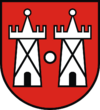Płońsk facts for kids
Quick facts for kids
Płońsk
|
|||
|---|---|---|---|

Main square (15 Sierpnia Square)
|
|||
|
|||
| Country | |||
| Voivodeship | Masovian | ||
| County | Płońsk | ||
| Gmina | Płońsk (urban gmina) | ||
| Established | 10th century | ||
| Town rights | 1400 | ||
| Area | |||
| • Total | 11.6 km2 (4.5 sq mi) | ||
| Population
(2022-12-31)
|
|||
| • Total | 21,591 | ||
| • Density | 1,861/km2 (4,821/sq mi) | ||
| Time zone | UTC+1 (CET) | ||
| • Summer (DST) | UTC+2 (CEST) | ||
| Postal code |
09-100
|
||
| Area code(s) | +48 023 | ||
| Car plates | WPN | ||
| Highways | |||
| National roads | |||
| Voivodeship roads | |||
| Website | http://www.plonsk.pl | ||
Płońsk is a town in central Poland. It has about 21,591 people living there (as of 2022). The town is located by the Płonka river in a historical area called Mazovia. It is the main town of Płońsk County in the Masovian Voivodeship.
Contents
History of Płońsk
Early Beginnings and Town Rights
Archaeologists believe that a strong fort, called a gord, was built in Płońsk around the late 900s. This was during the time of the early Polish state. The first written mention of Płońsk was in 1155.
Over time, a community grew around the fort. Many people living there worked on the land. In 1400, Siemowit IV, a duke of Masovia, gave Płońsk special town rights. This meant that merchants and craftspeople started to move to the town. Płońsk was also on an important trade route between Toruń and Brześć.
Płońsk in the 20th Century
In the early 1900s, Płońsk had about 10,000 people. Half of them were Poles and half were Jews. The town was known for its clothing industry. Jewish residents mostly lived within the town, while Poles often lived in the surrounding countryside.
A very important person, David Ben Gurion, was born in Płońsk on October 16, 1886. He later became the first Prime Minister of Israel. Many Jewish people from Płońsk, like him, moved to Palestine. They wanted to help build a Jewish homeland there.
World War II and Its Impact
During World War II, in September 1939, Germany invaded Poland. German soldiers entered Płońsk. They committed many terrible acts against the people. The town was taken over by Nazi Germany and renamed Plöhnen.
In 1940, the German occupiers forced about 1,000 Poles to leave their homes. These homes were then given to German settlers. In September 1940, Jewish people from Płońsk and nearby areas were forced into a special area called a ghetto. Life in the ghetto was very hard, and a serious illness called typhus spread quickly.
From October 1942, the Jewish prisoners from the ghetto were sent to the Auschwitz extermination camp. This was a very sad time for the town. In 1943, members of the local Polish resistance were punished by the Germans. Just before the Germans left in January 1945, they killed 78 Poles in the town.
Places to See in Płońsk
Płońsk has several interesting places to visit:
- Saint Michael Archangel Church - This church was once a monastery. It was built before 1417 by Duke Siemowit IV and his wife Aleksandra.
- David Ben Gurion’s family home - This old house at 21A 15 Sierpnia Square is where David Ben Gurion lived until 1908.
- The Memorial House - Located at 2 Warszawska Street, this is a museum about the Jewish community of Płońsk.
- David Ben Gurion Square - This square has a monument marking the place where David Ben Gurion was born.
- The old Sienkiewiczówka manor - This manor house is in the Poświętne district. It was once the home of Henryk Sienkiewicz, a famous Polish writer who won the Nobel Prize. He wrote his first novel here.
-
Manor in the Poświętne district, home of Polish novelist and Nobel Prize laureate Henryk Sienkiewicz in the 1860s
Population Changes in Płońsk
| Historical population | ||||||||||||||||||||||||||||
|---|---|---|---|---|---|---|---|---|---|---|---|---|---|---|---|---|---|---|---|---|---|---|---|---|---|---|---|---|
|
|
|||||||||||||||||||||||||||
Museums in Płońsk
- Płońsk Memorial House - This museum has an exhibition called “Glance and recall.” It shows the history of the Jewish community in Płońsk, the Holocaust, and the life of David Ben-Gurion.
- Muzeum Ziemi Płońskiej - This is a local history museum that is being created at the railway station. It is planned to open in the spring of 2024.
Getting Around Płońsk
Płońsk is located where several important roads meet. These include the Polish S7 highway and National roads No. 10 and 50. The town also has a railway station.
Events in Płońsk
- Memoriał Andrzeja Trochanowskiego - This is a one-day cycling race that happens every year on May 1.
- Jewish Culture Festival - This festival takes place every year in October or November.
In 2018, people in Płońsk celebrated the 70th anniversary of the country of Israel. They honored David Ben-Gurion, who was born in Płońsk.
Famous People from Płońsk
- Jan Walery Jędrzejewicz (1835-1887), a Polish astronomer and doctor.
- Henryk Sienkiewicz (1846–1916), a famous Polish writer and journalist who won the Nobel Prize.
- David Ben-Gurion (1886–1973), the first Prime Minister of Israel.
- Joanna Mucha (born 1976), who was the Minister of Sport and Tourism of Poland from 2011 to 2012.
- Tomasz Majewski (born 1981), a Polish shot putter who won two Olympic gold medals.
See also
 In Spanish: Płońsk para niños
In Spanish: Płońsk para niños









